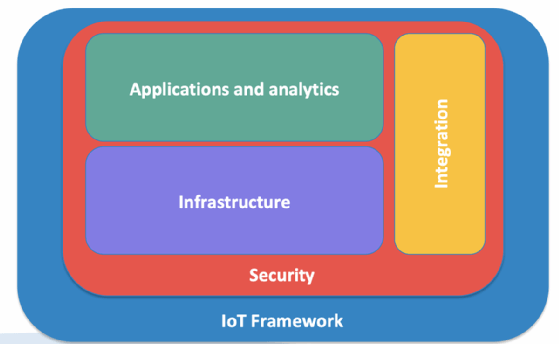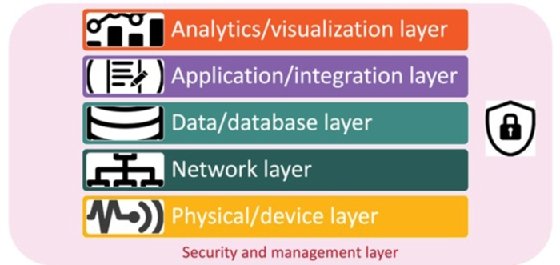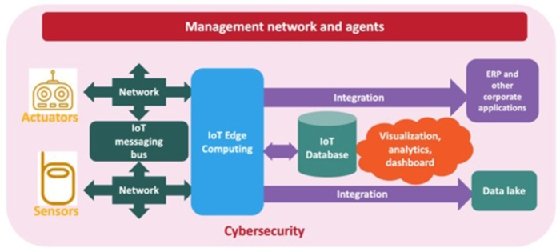6 IoT architecture layers and components explained (original) (raw)
Having a clearly defined IoT architecture framework greatly improves the chances for success of an enterprise's connected deployment.
Enterprise IoT has been reportedly growing at around 20% year over year, touching virtually every industry and organization. That means enterprise technology professionals must prepare for the influx of IoT in their environments.
But how? The first step is to evaluate the business purpose of IoT in the organization. That could be to drive revenue, cut costs, optimize business processes or simply fit into an overall technology strategy.
Once the role of IoT is clear, the next step is to build out the architecture. Although there's no one-size-fits-all architecture, it makes sense to build a general architecture that covers all the components that can be standardized across the organization and then develop specific architectures that are customized to achieve business needs.
Why? Data shows that enterprises with an IoT architecture are significantly more successful than those without. Successful companies -- those that rank in the top third of companies when it comes to saving money, driving new revenue or improving business processes via IoT -- are 34% more likely to have an IoT architecture than less successful firms.
What is IoT architecture?
The best place to start is by first defining architecture. Fundamentally, an architecture is a diagram or model that comprises two parts: the key technology components that make it up and the relationship between those components.
In other words, an architecture is more than a list of necessary technological components, but it does start with that list. It goes on to define how these components interact or engage with each other.
Some further definitions are in order. Technology component means a system, device or piece of software that delivers a specific technical capability. The cloud isn't a technology component, though it might be where a technology component is located, e.g., a cloud firewall. Components can be hardware, software or a mix of the two, and they can be defined at a high level (firewall) or a granular level (link-layer packet filtering). Defining the components at the right level is part of the challenge of crafting an architecture. For example, in an IoT architecture, those components are likely to include connected devices, smart devices, sensors and actuators.
What are the components of IoT architecture?
At a high level, an IoT architecture includes four key components (see Figure 1):
- Applications and analytics component. This piece processes and displays the information collected via IoT. It includes analytics tools, AI and machine learning, and visualization capabilities. Technologies for this component range from traditional analytics and visualization packages, such as R, IBM SPSS and SAS, to specialized IoT tools and dashboards from cloud providers, such as Amazon, Google, Microsoft, Oracle and IBM, as well as application suite vendors, including SAP, Salesforce and others.
- Integration component. This is the component that ensures that the applications, tools, security and infrastructure integrate effectively with existing companywide ERP and other management systems. Providers include the aforementioned software and cloud players, as well as a range of open source and middleware products, such as Oracle Fusion Middleware, LinkSmart, Apache Kafka and DynThings Open Source IoT Platform.
- Security and management component. IoT security includes securing the physical components of the system via firmware and embedded security providers, which include both traditional security providers that have IoT capability and IoT-specific providers. Examples include Armis, Auth0, Cisco, Digicert, Forescout, Ordr, Palo Alto, Rapid7, SimpliSafe and SonicWall.
- Infrastructure component. This includes physical devices -- smart sensors, which capture information, and actuators, which control the environment. It also includes the network on which the sensors or actuators reside; typically, though not always, this is a wireless network, such as Wi-Fi, Bluetooth, 4G or 5G. Other wireless options are emerging, including Long Range WAN and low-power WAN.

Figure 1. The four components of IoT architecture
The relationship between the components is the second part of the architecture. By relationship between, we mean how components communicate with each other and what sorts of information are exchanged. This can include data flow, metadata flow, control information or no information at all. Software components often communicate via APIs, and network layer components typically communicate via network protocols.
Speaking of layers, architects often think in terms of component layers, such as a network layer, perception layer, processing layer, physical layer, gateway layer, platform layer, device layer, business layer, security layer, sensor layer and so on.
The concept of a layer is that it comprises a set of capabilities that communicate with one another but, for the purpose of other components, can be treated as a single entity, with a single transparent entity.
So, for instance, in an IoT architecture, the application layer does not need to know what type of physical network carries the data. All the network devices constitute the network layer that transports traffic as needed by the applications.
What are the 6 layers of IoT architecture?
We define the six layers of IoT architecture as described subsequently -- note that, in some cases, layers are made up of sublayers; this is a common characteristic in complex architectures, such as that of IoT (see Figure 2):
- Physical/device layer. This includes the sensors, actuators, and other smart devices and connected devices that constitute the physical layer and device layer. These smart devices capture data (sensors), take action (actuators) or, sometimes, both.
- Network layer. This comprises the network devices and communications types and protocols, e.g., 5G, Wi-Fi, Bluetooth, etc. Although many IoT architectures rely on general-purpose network layers, there is an increasing trend to move to dedicated IoT-specific networks.
- Data/database layer. This also includes the database platform layer. There are a range of databases used for IoT architectures, and many organizations spend a fair amount of time selecting and architecting the right IoT databases for them.
Together, the physical layer/device layer, network layer and data/database layers constitute the infrastructure component discussed previously.

Figure 2. The six layers of IoT architecture
- Analytics/visualization layer. This layer comprises the analytics layer, visualization layer and perception layer. In essence, this layer's focus is on analyzing the data provided by IoT and providing it to users and applications to make sense of.
- Application/integration layer. This is the layer of applications and platforms that work together to deliver functionality from the IoT infrastructure to the business. In other words, the application layer, platform layer and integration layer are what provides the business value from the IoT infrastructure. The processing layer and business layer are all part of the larger application/integration layer.
- Security and management layer. As the name implies, this layer encompasses both the security layer and the management layer. Strictly speaking, this is not a layer as it connects with all the other layers to provide security and management. But it's an important component that's worth considering at every layer.
These layers go from bottom to top like the Open Systems Interconnection model, which was the original source of the layering concept (see Figure 3).

Figure 3. An overview of the IoT architecture model
Conclusion and recommendations
Enterprise IT, operational technology and IoT professionals should develop IoT projects and initiatives based on a consistent architecture. That doesn't mean using the exact same tools and technologies for every project, but rather making sure that every component is properly instantiated for the specific project and that technology professionals have thought about all the layers, including the network layer, perception layer, processing layer, physical layer, gateway layer, platform layer, device layer, business layer, security layer and sensor layer.
Next Steps
IoT basics: A guide for beginners
Top advantages and disadvantages of IoT in business
11 top IoT online courses to boost your career (free and paid)
 By: Robert Sheldon
By: Robert Sheldon  Ultimate IoT implementation guide for businesses
Ultimate IoT implementation guide for businesses  By: Stephen Bigelow
By: Stephen Bigelow  Testing IoT devices helps ensure deployment success
Testing IoT devices helps ensure deployment success  By: Mary Pratt
By: Mary Pratt  embedded systems programming
embedded systems programming  By: Kinza Yasar
By: Kinza Yasar